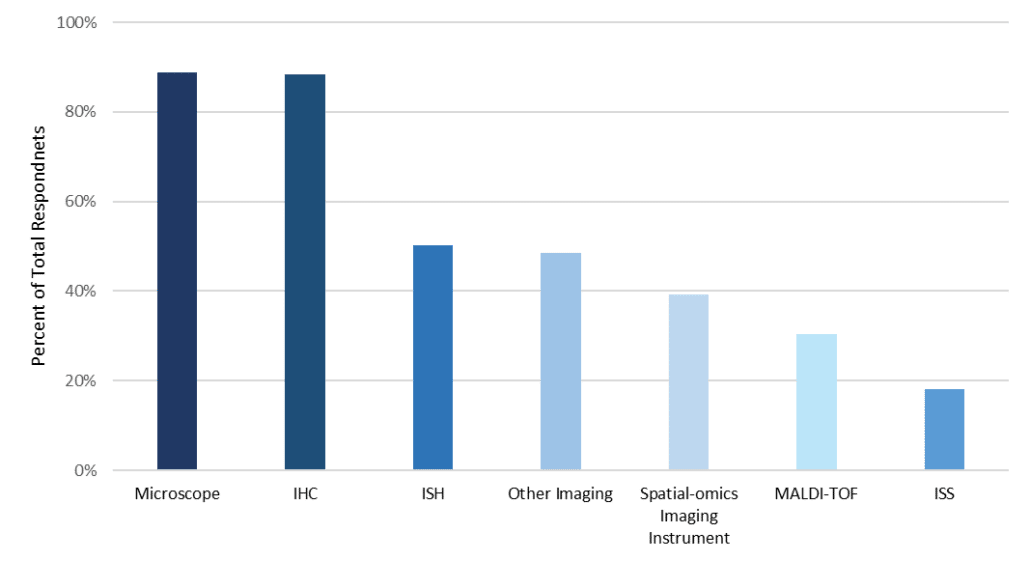Three Spatial Biology Trends to Watch
Traditionally, genomic and proteomic studies have focused on examining the molecular composition of isolated cells or tissues. However, these approaches often lack the context of the cells or tissues within their spatial environment. Improvements in imaging technology coupled with next generation sequencing are simultaneously widening and focusing the lens to look at proteins and transcripts expressed in single cells and even within subcellular locations, against their environmental backdrops.

Figure 1: Respondents were asked what instruments and assays were used in their laboratories.
Spatial Transcriptomics: Fastest Growing New Technology?
Spatial Transcriptomics was recognized as the “Method of the Year, 2020” by Nature Methods. This groundbreaking technique, encompassing everything from manual sample preparation to automated slide stainers, microscopes and various other imaging techniques, has become a cornerstone for researchers seeking in-depth insights into biological systems. Over the past few years, there has been a surge in demand for commercially available platforms that enable spatial analysis of gene transcription.

Figure 2: 5-year trajectory of the spatial biology instrument market
A comprehensive survey of end users, combined with SDi’s secondary analysis of the market, projects promising growth figures and anticipates brisk growth for spatial biology demand over the next five years. The wide array of tools employed across the spatial biology workflows is a key component in the market’s growth. Looking at the basic workflow of spatial analysis, the journey begins with sample preparation involving various consumables such as antibodies, probes, buffers, and other reagents. As the process unfolds, microscopes and other imaging instruments come to the forefront, capturing the spatial locations of targeted biomolecules while preserving the spatial context of the tissue environment. Finally, specialized software enters the scene, mapping the genes of interest and deciphering the complex imaging data.
Top Survey Findings: Tools and Costs
SDi’s survey on spatial biology sheds light on the tools most used by scientists in the lab. Microscopes emerged as the top equipment employed, while immunohistochemistry reigned as the primary technique for conducting spatial analysis. Delving deeper into the survey findings, an interesting divide was observed between end market industries. Microscopes, with their cost-effectiveness, found widespread use in settings where budget constraints are a common reality. In contrast, sectors equipped with heftier budgets leaned towards high-ticket items, like dedicated spatial-omics imaging instruments. These advanced instruments, boasting six-figure price tags and automated features, present a robust solution for those with ample capital resources. However, it’s worth noting that cost remains a significant roadblock for the broader adoption of spatial biology, as echoed by respondents in the survey.
While spatial-omics imaging instruments may be considered out of reach by some, their potential to improve analysis time, throughput, resolution, and precision are expected to propel instrument adoption. Further, the promise of ongoing innovations in these instruments, coupled with the insights spatial biology provides to scientists in research and development, positions the field for robust growth in the coming years.
Beyond cost considerations, the technique’s potential to identify important biomarkers and enhance our understanding of current and future disease mechanisms underscores its significance. As the field continues to evolve, spatial analysis holds promising potential, offering a lens through which we can answer unanswered questions and lead to groundbreaking treatments. This alone warrants our investment.
“It is very exciting to discover how the cells and tissues are arranged inside body and understand their interactions in detail with the help of three-dimensional visualization.” – Respondent Insights
Spatial biology has brought invaluable insights into cancer research, immunology, pathology and beyond. Not only is it expanding out understanding of biological systems, but also accelerating development of medicines and therapeutics. To get more in-depth information on the market for spatial biology, as well as the insights and trends among end users in the lab, check out SDi’s Spatial Biology 2023 Market Opportunity Report. The report provides detailed information on the market for spatial-omics instruments and consumables, vendor share, and forecasts segmented by technique, region, end-market, and function. The report also includes a survey of spatial biology experts from North America and Europe, with respondents from the pharma/biotech/CRO, clinical, and public sectors, offering insights into the spatial biology techniques, instruments and consumables they use in their workflows, product usage and purchasing, and vendor usage.

